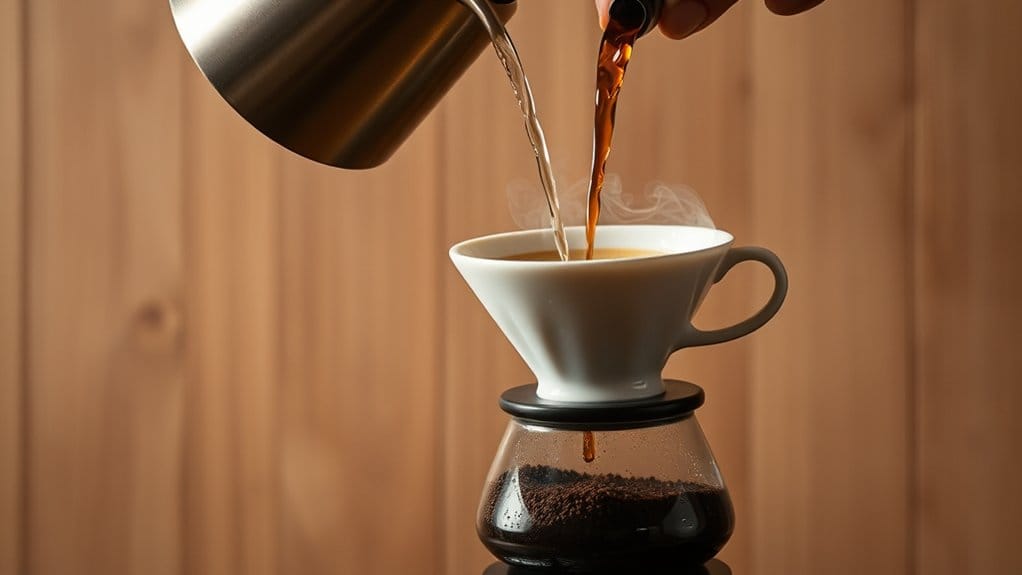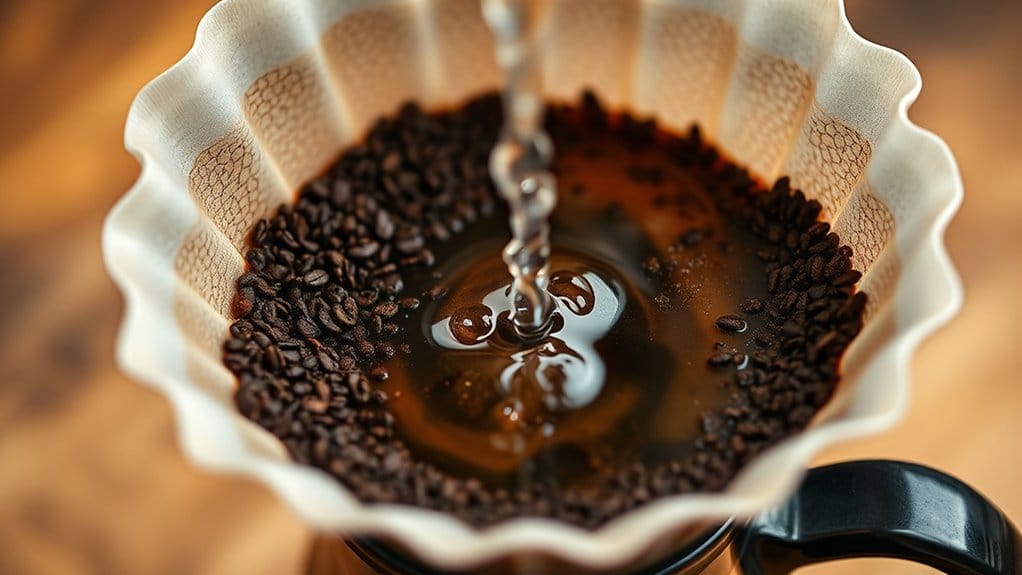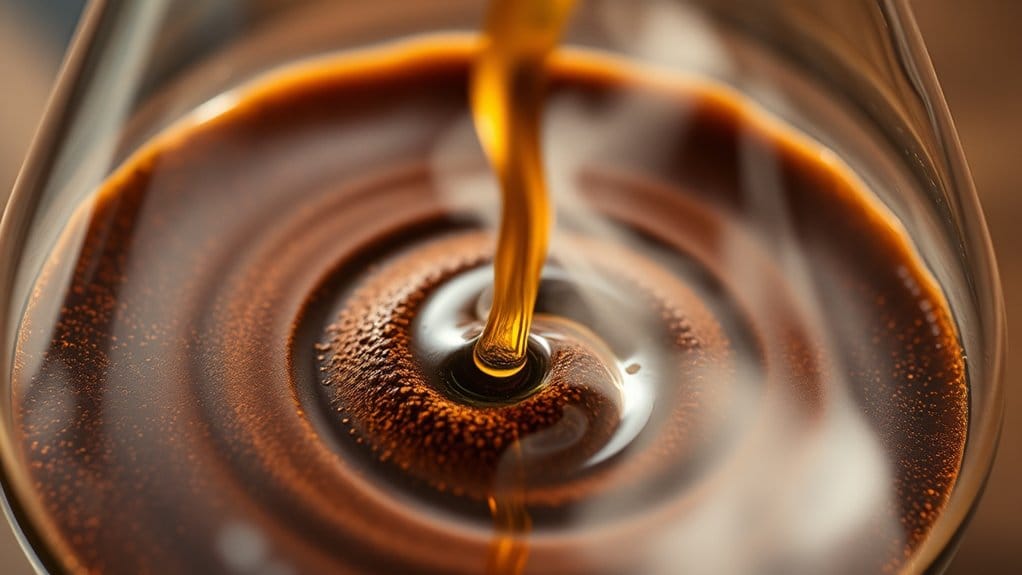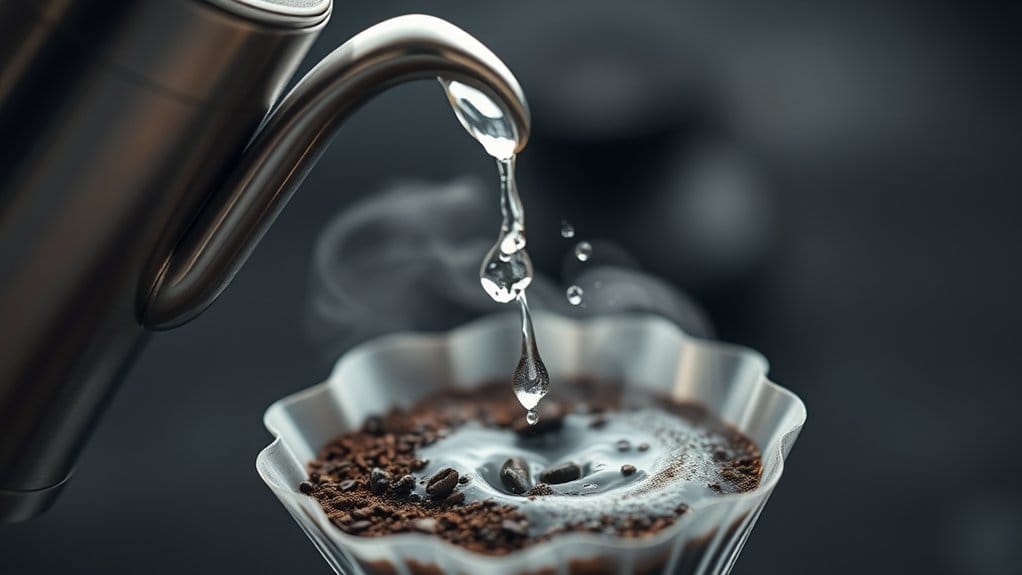Physical Address
304 North Cardinal St.
Dorchester Center, MA 02124
Physical Address
304 North Cardinal St.
Dorchester Center, MA 02124

To brew better coffee, mastering your pour patterns is key! Start with a gentle circular pour to avoid channeling. Try dividing your pour into equal pulses to keep the grounds evenly damp. Don’t forget to adjust your pouring height for that “avalanche” effect, which can boost flavor. Keep shaking and experimenting until you find what works best for you and your taste buds. Curious about other techniques to enhance your brewing skills? There’s more to investigate!

When you start brewing coffee, understanding the bloom phase can really enhance your experience.
The bloom is like waking up your coffee grounds. Pour a little hot water over your freshly ground beans, and watch them bubble and swell. That’s the CO2 escaping! This phase takes about 30 to 60 seconds, depending on how fresh your beans are. Blooming involves adding a small amount of water and allowing it to steep for about 30 seconds, ensuring that all the gases are efficiently released before you proceed with the brewing process. By encouraging trapped CO2 release, you can experience a smoother and more balanced flavor profile. Moreover, using techniques like AeroPress brewing can maximize the benefits of the bloom phase.
Think of it as giving them a spa treatment. By doing this, you guarantee even extraction, so your coffee tastes balanced and delicious, not sour. A good bloom looks like a bubbly froth on top of your grounds, signaling it’s time to pour more water.
Welcome the bloom phase, and you’ll boost your brewing game! Your taste buds will thank you!
Mastering the circular pour technique is your ticket to a better cup. First, use a gooseneck kettle for controlled flow. As you pour in a circular motion, you’ll guarantee even saturation of the coffee grounds, promoting uniform extraction. This method reveals the full range of flavors hiding in your beans, making every sip a delight. Each pour celebrates the artistry behind coffee brewing, enhancing your overall experience. To ensure optimal extraction, pay attention to the coffee-to-water ratio, as it directly influences the strength and flavor of the brew.
Using freshly ground coffee from a quality grinder enhances the extraction process, ensuring the beans release their aromatic oils effectively. Want even more delicious results? Try pulse pouring or a two-stage pour for improved body. And remember, water temperature matters—keep it between 90-96°C.
With practice, you’ll brew a smooth, clean cup that’ll impress your morning self. So, are you ready to become a coffee connoisseur?

Whether you’re just getting started with coffee brewing or you’ve been at it for a period, the spiral pouring technique can take your morning ritual to a whole new level.
Instead of just splashing water everywhere, spiral pouring evenly wets all the coffee grounds. You start in the center and move outward, which helps flavors shine through. Think of it like a gentle sway with your kettle. Not only does it prevent that bitter, burnt taste, but it encourages the sweet, complex notes to come alive. Controlled agitation is essential for achieving better control over how much flavor you extract! Additionally, this method aligns with the importance of precision in coffee-to-water ratio as it helps achieve optimal extraction.
Plus, using a gooseneck kettle makes it even easier. Who knew brewing coffee could feel like an art? Give it a whirl, and taste the difference!
Dividing your pour into equal pulses isn’t just a technique; it’s a groundbreaking shift for your coffee brewing routine!
Think of pulse pouring like taking your coffee on a little vacation, one sip at a time. Instead of pouring all your water at once, you break it down into smaller, timed intervals—like six 50g pulses for a 300g brew. This controlled approach keeps your coffee bed calm, preventing unwanted turbulence and channeling.
Each carefully timed pulse helps brew your coffee with precision and clarity. It lets you fine-tune the flavor as you ensure even extraction. Certainly, it might take a bit longer, but you’ll savor a cup that’s consistently delicious. Who wouldn’t want that?

Achieving even saturation across your coffee grounds is like ensuring every player gets a fair shot in a game—everyone deserves the best chance to shine!
You want to pour in a circular motion, starting from the center and moving outward. This helps avoid channeling, where water takes an easy path, leaving some grounds high and dry.
Leveling your grounds out, perhaps by gently shaking, is also crucial. It allows water to flow smoothly, maximizing extraction.
Think of pulse pouring or continuous pouring as your playbook strategies. Incorporating the golden ratio of coffee to water can also enhance your brewing effectiveness.
Finally, don’t forget that little tap on your brewing device after pouring; it might just be the final cheer your coffee needs for a balanced flavor.
Happy brewing!
After you’ve mastered even saturation with your coffee grounds, it’s time to zoom in on the initial bloom. This magical moment kicks off when you add hot water to fresh grounds, releasing trapped carbon dioxide.
Watch for those bubbles! They’re signs of freshness, showing off your coffee’s quality. The bloom usually lasts 30 to 60 seconds, so take a breath and let the coffee hydrate. This process softens the grounds and prepares them for best extraction.
You’ll notice brighter aromas and smoother flavors, free from bitterness. It’s like a warm-up before the big race! So, don’t skip this step; it makes a huge difference in your coffee’s taste, ensuring every sip counts. Moreover, using the ideal water temperature between 195°F and 205°F further enhances the extraction process.
Happy brewing!

It’s amazing how a little attention to detail can improve your coffee game! Start by leveling your coffee bed. Give your brewer a gentle shake to avoid those bothersome dry spots.
Use a consistent grind size and distribute the grounds evenly. Remember, a loosely packed bed helps water flow better.
When you pour, try pulse pouring in 3 to 4 equal parts. This helps keep everything nice and damp. Pour in a controlled spiral, moving from the center outwards. It’s like painting a masterpiece, but with coffee!
Watch for dry spots or overflow, and adjust as needed. By controlling these factors, you’ll achieve balanced extraction and savor every delightful sip. Additionally, maintaining a steady stream of water is crucial for optimal flavor.
Enjoy the expedition of perfecting your brew!
Immerse yourself in the world of agitation techniques, and you’ll reveal how they can transform your coffee brewing experience!
Agitation, like stirring or swirling, can really make a difference to your brew. Ever tried stirring with a spoon right after a pulse pour? This helps mix grounds evenly.
Swirling’s another fun option—just lift and gently rotate your brewer for a quick boost. How about shaking? It works wonders in cold brews, ensuring flavors mingle without bitterness.
Experiment with different methods and see how they affect your coffee’s richness. Just remember, too much agitation can lead to bitterness, so finding that sweet spot’s key. Opened coffee should be stored properly to maintain flavor integrity to ensure you preserve the best taste during brewing.
Who knew playing with your coffee could unveil new flavors? Happy brewing!

Adjusting pouring height can significantly affect your coffee extraction, and it’s something every coffee lover should try. When you pour from a higher position, around 8 to 10 inches, you create more agitation, helping the water mix well with the coffee grounds. This causes an “avalanche” effect, which can boost flavor extraction.
On the other hand, if you pour too aggressively, you risk clogging the filter or over-extracting, especially with dark roasts. Pouring too low might lead to uneven extraction, leaving you with weak coffee. Balance is key here! Additionally, the grind size of your coffee can play a vital role in the extraction process, impacting the final flavor profile.
Try starting high for lighter roasts and lowering yourself for darker ones, all during a steady process. It’s all about experimenting and having fun with your brew. Enjoy the experience to perfect coffee!
Refining your pour patterns can be a delightful voyage that transforms your coffee-making experience. By practicing regularly, you’ll develop muscle memory, making your pours more precise and consistent.
It’s all about that sweet spot—try the 4:6 pour method to balance flavors and watch the bloom phase like a hawk. Those little bubbles? They’re your friends.
When pouring, use circular motions to avoid uneven saturation, and remember, a steady, slow flow is your best buddy for extraction.
You might even want to keep a journal of your pours. Noticing changes in taste helps dial in your technique. Practicing your pour patterns can lead to an espresso with optimal flavor extraction that brings out the best in your coffee beans.
Just think: with practice, you’ll be creating coffee so good, even your morning self will be impressed!
Yes, different coffee types absolutely affect pour pattern effectiveness. Each variety has unique extraction characteristics; understanding these helps you tailor your technique, ensuring ideal flavor and avoiding issues like bitterness or uneven saturation during brewing.
Water quality greatly impacts extraction during pouring. You’ll want to guarantee balanced mineral content and the right pH level to achieve the best flavor clarity. Poor water may lead to under or over-extraction, diminishing your coffee experience.
To improve pour pattern consistency, you’ll want to use a gooseneck kettle for controlled pouring, a gram scale for precise measurements, and a distribution tool to guarantee even coffee bed density before brewing.
Yes, you should definitely preheat your pouring vessel. It maintains ideal brewing temperatures, prevents heat loss, and improves flavor extraction. You’ll notice a significant difference in aroma and taste with properly preheated equipment.
You should clean your equipment daily to guarantee peak flavor. Removing coffee residues and oils prevents bitter tastes. Weekly deep cleans and monthly descaling further maintain quality, verifying your coffee consistently tastes its best.